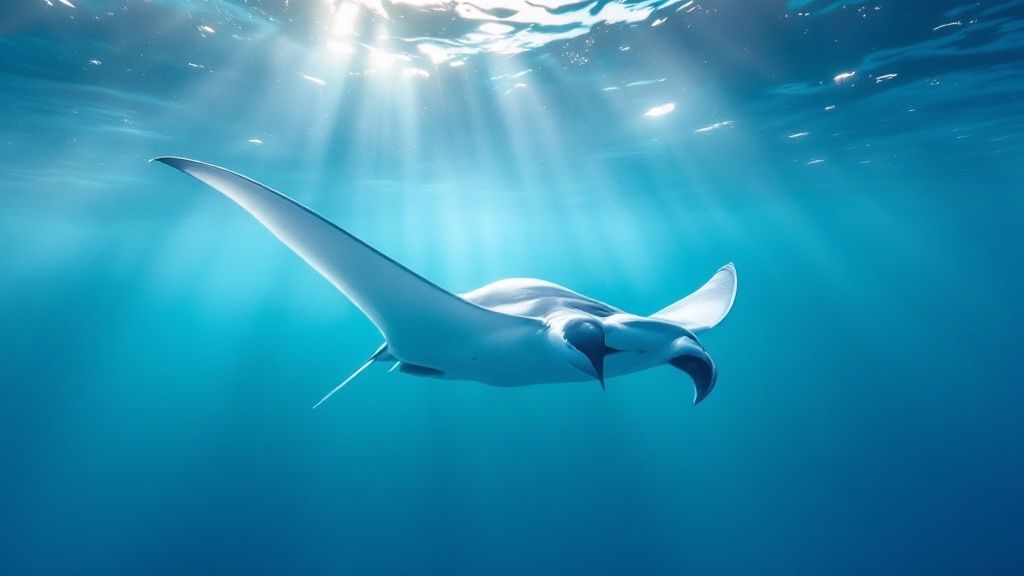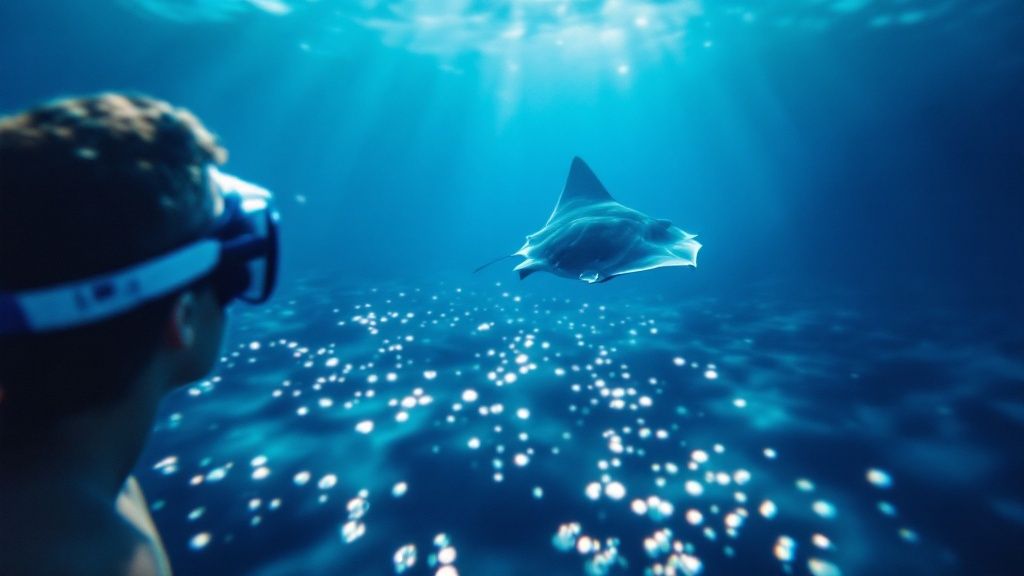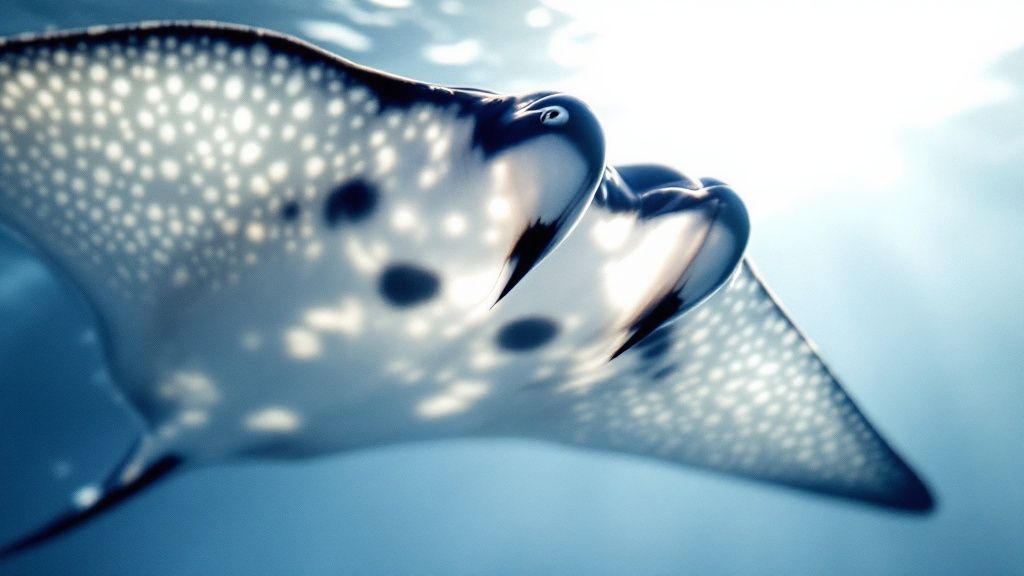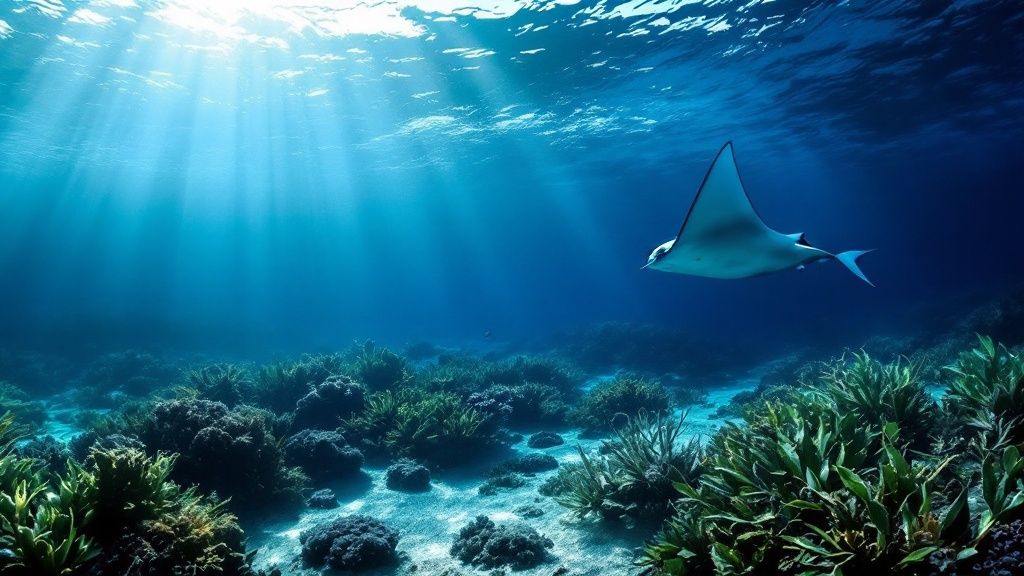The Underwater Ballet: Why Manta Ray Snorkeling Kona Captivates

Manta ray snorkeling in Kona isn't just another item to check off your vacation bucket list. It's an immersive experience, a chance to connect with the raw beauty and power of these gentle giants in their natural environment. Kona, with its volcanic landscape, offers the perfect backdrop for this underwater ballet.
The nutrient-rich waters surrounding the island are a haven for plankton, the manta ray's main food source. This abundance of food is what keeps the manta rays returning, creating a truly spectacular show for lucky snorkelers.
The Kona Coast: A Manta Ray Paradise
Kona's volcanic slopes create a unique underwater topography. Combined with nutrient-rich currents, they attract vast quantities of plankton. These microscopic organisms draw in manta rays, creating a reliable feeding ground.
Manta ray snorkeling in Kona is a highly sought-after activity, drawing approximately 80,000 participants annually. Tour operators report an 85-90% success rate for manta ray encounters, making Kona a prime location for practically guaranteed sightings. Specialized lights used by tour operators amplify the natural phenomenon, creating an illuminated feast that further enhances the viewing experience. Find more detailed statistics here.
Up Close and Personal with Gentle Giants
Imagine floating on the surface, looking down at creatures with 12-foot wingspans gracefully gliding below. These gentle giants often perform acrobatic barrel rolls as they feed, sometimes coming within inches of snorkelers.
This proximity creates an unparalleled connection with these magnificent animals. The experience is often described as life-changing, fostering a deep appreciation for these ocean giants. This close interaction creates a truly immersive and unforgettable experience. How to master night snorkeling with manta rays.
Why Kona's Manta Rays Captivate
Kona offers a unique and reliable opportunity to witness manta rays in a way few other places can match. The consistent food source ensures their regular presence, making Kona one of the best locations worldwide for this activity. Manta Ray Snorkel Kona.
Reputable tour operators like Kona Honu Divers, Manta Ray Night Snorkel Hawaii, Kona Snorkel Trips, and Captain Cook Snorkeling Tours prioritize sustainable and ethical practices. This commitment ensures the well-being of the manta rays and their environment, preserving this magical experience for years to come.
Secret Spots: Where to Find Kona's Magnificent Mantas

Not all manta ray snorkeling experiences in Kona are created equal. The location you choose plays a vital role in the kind of encounter you'll have. Understanding the unique characteristics of Kona’s top viewing spots can greatly enhance your manta ray adventure.
Makako Bay (Garden Eel Cove): A Manta Ray Hotspot
Makako Bay, also called Garden Eel Cove, is a popular spot for manta ray snorkeling. This sheltered bay boasts calm, shallow waters and a sandy bottom, perfect for both new and seasoned snorkelers. This special environment nurtures a thriving ecosystem, rich with the plankton that attracts these gentle giants.
The abundance of garden eels in Makako Bay adds to the area's vibrant marine life. These eels, swaying gracefully in the current, provide a captivating backdrop to the manta ray show. Their presence also signals a healthy ecosystem, further supporting the high concentration of plankton that draws the mantas in.
Keauhou Bay: A Natural Manta Buffet
Keauhou Bay offers a different, but equally amazing, manta ray snorkeling experience. The bay's unique current patterns create a natural buffet for manta rays, attracting them throughout the year. These currents carry nutrient-rich waters into the bay, ensuring a consistent food source for the mantas.
Keauhou Bay's unique underwater landscape also influences how mantas feed. The combination of currents and ocean floor creates upwellings that concentrate plankton near the surface. This predictable feeding pattern makes it easier for snorkelers to witness the mantas’ graceful movements.
To help you choose the right spot for your adventure, we've compiled a comparison table highlighting the key features of both locations:
Comparison of Top Manta Ray Snorkeling Locations in Kona
This table compares the key features and characteristics of the primary manta ray snorkeling sites in Kona to help visitors understand the differences and choose the best option for their experience.
| Location | Unique Features | Best Time | Accessibility | Typical Water Conditions | Success Rate |
|---|---|---|---|---|---|
| Makako Bay (Garden Eel Cove) | Shallow, sandy bottom; abundant garden eels; protected bay | Sunset | Easy access from shore or boat | Calm, clear | High (often higher concentration due to proximity and protection) |
| Keauhou Bay | Consistent currents and nutrient-rich waters; unique underwater topography creates upwellings | Year-round | Boat access | Can be slightly choppier depending on currents | High |
As you can see, both Makako Bay and Keauhou Bay offer incredible opportunities to snorkel with manta rays. While Makako Bay is often favored for its calm, shallow waters and abundant marine life, Keauhou Bay provides a unique perspective on manta ray feeding behavior. Both locations boast high success rates for manta ray sightings.
Factors Influencing Site Selection
Ocean conditions play a significant role in choosing the best manta ray snorkeling spot on a given night. Experienced tour operators, like those mentioned in Top 10 Scuba Diving Destinations in the United States, consider factors such as water clarity, current strength, and wind conditions when selecting a location. This guarantees the safest and most rewarding experience for everyone.
For example, strong currents can be difficult for beginners, while poor visibility can impact the manta ray viewing experience. Operators carefully assess these conditions before deciding on the best spot for each tour. Reputable tour operators prioritize safety and aim to provide the best possible viewing conditions for their guests. This attention to detail enhances the overall manta ray snorkeling experience. You can also find more detailed statistics at Jack's Diving Locker. This careful planning ensures a memorable and safe experience for all.
Night Magic: The Manta Ray Snorkeling Experience Decoded

So, you're thinking about a manta ray snorkeling adventure in Kona? It's an incredible experience, carefully planned by tour operators from start to finish. Companies like Kona Honu Divers and Captain Cook Snorkeling Tours are known for their expertise in these unforgettable encounters.
From Shoreline to Ocean Floor
The adventure begins with a boat trip to a designated manta ray viewing area. These spots, often near Keauhou Bay or Makako Bay, are known for their consistent manta ray presence and calm waters. They provide the perfect feeding grounds for these gentle giants.
Once you arrive, the magic begins. Specialized lighting systems are placed in the water. These lights attract plankton, the manta ray's main food source, creating a "plankton buffet" and drawing the mantas closer to the surface.
Floating With Giants
You'll then enter the water, often with a flotation device. Many operators use custom boards with lights and handles, or provide pool noodles. This allows snorkelers of all skill levels to comfortably observe the mantas without disturbing them. Just relax and enjoy the show! For more info on night dives, see this article: How to master manta ray night dives with Kona Honu Divers.
The Manta Ray Ballet Begins
Suddenly, the manta rays emerge from the darkness. These majestic creatures, some with wingspans of 10 feet or more, glide through the illuminated water. They perform graceful barrel rolls and loops as they feast on the plankton, often coming incredibly close to the snorkelers. It’s a truly breathtaking spectacle.
Enhancing Your Experience
Experienced guides add another dimension to the adventure. They ensure your safety and offer valuable insights into manta ray behavior. They might even identify individual mantas by their unique spot patterns.
For many, this close encounter is a life-changing experience. It fosters a deeper appreciation for these incredible creatures and the importance of ocean conservation. This emotional connection is what makes manta ray snorkeling in Kona so special. Learn more about manta ray snorkeling in Kona. Explore additional options for your manta ray adventure: Manta Ray Night Snorkels, Manta Ray Snorkel Tours in Kona.
The following table provides helpful information for planning your trip:
What to Bring on Your Manta Ray Snorkeling Adventure
This table provides a comprehensive packing list for manta ray snorkeling tours, indicating which items are typically provided by tour operators and which should be brought by participants.
| Item | Provided by Tour? | Importance | Notes |
|---|---|---|---|
| Snorkeling Gear (Mask, Snorkel, Fins) | Usually | Essential | Some tours offer prescription masks. |
| Wetsuit/Rashguard | Sometimes | Recommended | Provides warmth and sun protection. |
| Towel | Rarely | Essential | For drying off after the snorkel. |
| Reef-Safe Sunscreen | Bring Your Own | Essential | Protects you and the coral reef. |
| Waterproof Camera | Bring Your Own | Optional | Capture the amazing encounter. |
| Seasickness Medication | Bring Your Own | Optional | If prone to seasickness. |
| Underwater Light | Sometimes | Optional | Can enhance viewing in darker waters. |
| Flotation Device | Usually | Essential/Optional | Depending on personal preference and tour operator. |
Remember to check with your specific tour operator for details on what they provide. Packing appropriately will enhance your enjoyment of this unique experience.
Gentle Giants: The Fascinating World of Manta Behavior

Beyond the thrill of snorkeling with manta rays in Kona, lies a world of fascinating behavior. These graceful creatures possess a complex intelligence that continues to intrigue marine biologists. A truly magical experience is witnessing this phenomenon at night with a Manta Ray Night Snorkel Kona.
Decoding Manta Behavior
Mantas are far more than just filter feeders. They display intricate behaviors, including individual recognition and playful interactions. They’ve even been observed recognizing individual humans and engaging in playful behavior with divers and snorkelers.
This suggests an intelligence level beyond simple instinct. Mantas also possess impressive navigation skills, using mental maps to traverse the vast ocean. Learn more about why you should experience this wonder firsthand: Why should you go on a manta ray dive in Kona?
Oceanic Fingerprints: Identifying Individual Mantas
Scientists identify and track individual manta rays by their unique spot patterns on their underbellies. These patterns are like fingerprints, allowing researchers to monitor specific mantas over time.
Long-term tracking has revealed that some mantas have frequented Kona waters for decades, highlighting the area's importance as a critical habitat. By participating in manta ray snorkeling adventures in Kona, you contribute to ongoing research and conservation.
Conservation and Responsible Tourism
Detailed records of manta ray sightings in Kona have been meticulously kept for years, particularly by organizations like Manta Ray Advocates Hawaii. From 2009 to 2014, these records documented individual mantas, their condition, and locations.
In 2013, a statistical review identified the most frequently sighted mantas and analyzed their behavior. These efforts help understand manta ray travel patterns and behavior within their home range. More detailed statistics can be found here.
This knowledge is crucial for developing effective conservation strategies and managing tourism responsibly. Choosing reputable tour operators like Kona Honu Divers, Manta Ray Night Snorkel Hawaii, and Kona Snorkel Trips supports sustainable practices. You can also find similar experiences with Captain Cook Snorkeling Tours.
Participating in a Kona manta ray snorkel tour is more than just a memorable experience. It's a way to contribute to the preservation of these gentle giants, ensuring future generations can witness their magic.
Perfect Timing: When to Experience Manta Ray Snorkeling
Choosing the right time to go manta ray snorkeling in Kona can dramatically enhance your experience. While these graceful creatures are present throughout the year, certain conditions create a truly unforgettable encounter. Understanding these factors will help you plan the perfect manta ray adventure.
Why Nighttime Excursions Reign Supreme
Manta ray snorkeling in Kona is primarily a nighttime activity due to the manta rays' feeding habits. After sunset, microscopic plankton rise to the surface, attracted by the moonlight. This creates a feeding ground for the manta rays. Tour operators use specialized lights to further concentrate the plankton, bringing the mantas closer to the surface for optimal viewing.
Daytime snorkeling trips offer a smaller chance of seeing mantas, as they typically feed in deeper water during the day. The nighttime feeding frenzy, however, provides a much higher probability of witnessing these magnificent creatures. This concentrated activity makes for a more dynamic and exciting experience.
Seasonal Variations and Their Impact
Manta rays can be found in Kona's waters year-round. However, subtle seasonal variations can affect visibility. Water clarity is generally best during the drier months, from April to October. Even during the wetter winter season, sightings remain common. For more details, check out our article about the best times of year to see manta rays in Kona.
If your schedule is flexible, consider visiting during the drier months for potentially better visibility and calmer surface conditions. This can create a more comfortable and visually stunning snorkeling trip. However, the magic of encountering a manta ray transcends the season.
The Lunar Cycle's Influence
The moon phase plays a significant role in the manta ray feeding cycle. A full moon, while beautiful, can actually lessen the impact of the tour operators' lights, potentially dispersing both the plankton and the mantas.
A new moon, on the other hand, enhances the effectiveness of the lights, creating a more concentrated plankton gathering and attracting more manta rays. For a truly spectacular feeding frenzy, plan your trip around a new moon.
Ocean Currents, Temperature, and Weather
Ocean currents, water temperature, and weather conditions contribute to the ideal manta ray snorkeling experience. These conditions are constantly changing. Experienced operators, like Kona Honu Divers, are skilled at interpreting these factors and choosing the best viewing location each night.
Calm waters and clear visibility always enhance the viewing experience. While Kona typically boasts mild conditions, occasional strong currents or unexpected weather changes can impact visibility and comfort in the water. Choosing a seasoned operator ensures that safety and the quality of your experience are prioritized. They carefully monitor these factors and adjust plans accordingly.
Careful timing allows for full appreciation of the majesty of manta rays in their natural habitat. Learn more about our manta ray snorkeling tours in Kona. You might be interested in: Manta Ray Night Snorkels and Kona Manta Ray Snorkel Trips. For additional information on snorkel tours, explore Captain Cook Snorkeling Tours.
Choosing Your Guide: Finding the Perfect Manta Adventure
With numerous tour operators offering manta ray snorkeling in Kona, choosing the right one can be a daunting task. This decision can significantly affect your overall experience. This guide offers key insights to help you find the perfect manta ray adventure.
Beyond the Basics: What Sets Exceptional Tours Apart
Don't simply choose the cheapest tour. Consider these factors for a truly memorable experience:
-
Group Size: Smaller groups allow for more personalized attention from the guides and minimize disruption to the manta rays.
-
Equipment Quality: Comfortable, well-maintained snorkeling gear, including masks, snorkels, fins, and wetsuits, is crucial. Look for tours that offer flotation devices for a more relaxed viewing experience.
-
Guide Expertise: Knowledgeable guides with significant experience in manta ray behavior and the local marine environment can enhance your understanding and enjoyment.
-
Vessel Comfort: A comfortable and stable boat is important for a pleasant trip to and from the snorkeling site. Consider factors like seating, restroom facilities, and shade.
Safety First: Essential Protocols and Red Flags
Manta ray snorkeling, particularly at night, demands attention to safety. Reputable tour operators prioritize safety through these protocols:
-
Pre-Snorkel Briefing: A thorough briefing should cover essential procedures, including proper snorkeling techniques, respectful manta ray interaction, and emergency protocols.
-
Experienced Guides in the Water: Guides should be in the water with snorkelers, providing assistance and ensuring everyone's safety.
-
Proper Lighting: Responsible lighting attracts plankton without disorienting the manta rays or other marine life.
-
Well-Maintained Equipment: Regularly inspected and sanitized equipment minimizes risks and enhances comfort.
Avoid tours that disregard these protocols or display these red flags:
-
Overcrowded boats: This compromises safety and diminishes the manta ray viewing experience.
-
Inexperienced or Inattentive Guides: Guides should be actively engaged in ensuring everyone's safety and enjoyment.
-
Lack of Proper Lighting or Equipment: This can create a dangerous situation for both snorkelers and manta rays.
Conservation Commitment: Protecting Manta Rays for Future Generations
Responsible tours do more than just show you manta rays. They actively contribute to their conservation:
-
Supporting Research: Some operators work with research organizations, providing valuable data for ongoing studies.
-
Promoting Ethical Practices: Responsible operators educate guests about respectful manta ray interaction and minimize their environmental impact.
-
Adhering to Regulations: Reputable tours comply with local regulations regarding manta ray viewing to protect the population.
Accommodations for Special Needs
Manta ray snorkeling should be accessible to all. Consider operators who accommodate various needs:
-
Non-Swimmers: Flotation devices and individual attention can help non-swimmers enjoy the experience.
-
Children and Seniors: Tours catering to different age groups can offer tailored experiences for safety and comfort.
-
Mobility Challenges: Operators with accessible vessels and equipment can accommodate individuals with mobility limitations.
Booking and Preparation: Ensuring a Seamless Adventure
Before booking, clarify these details:
-
Booking Policies: Understand cancellation policies and rescheduling options, especially for inclement weather. Many offer a "manta guarantee," allowing you to reschedule if no mantas are sighted.
-
Inclusions: Confirm what is included in the tour price, such as snorkeling gear, wetsuits, and refreshments.
-
Preparation Tips: Follow the operator's pre-trip instructions regarding what to wear, what to bring, and any pre-snorkel preparations.
Choosing the right guide elevates a manta ray snorkeling experience from good to exceptional. By prioritizing safety, conservation, and personalized service, operators like Kona Honu Divers ensure an unforgettable adventure. Book your manta ray adventure with them today and experience the magic: Dive into the Kona Honu Divers Experience
